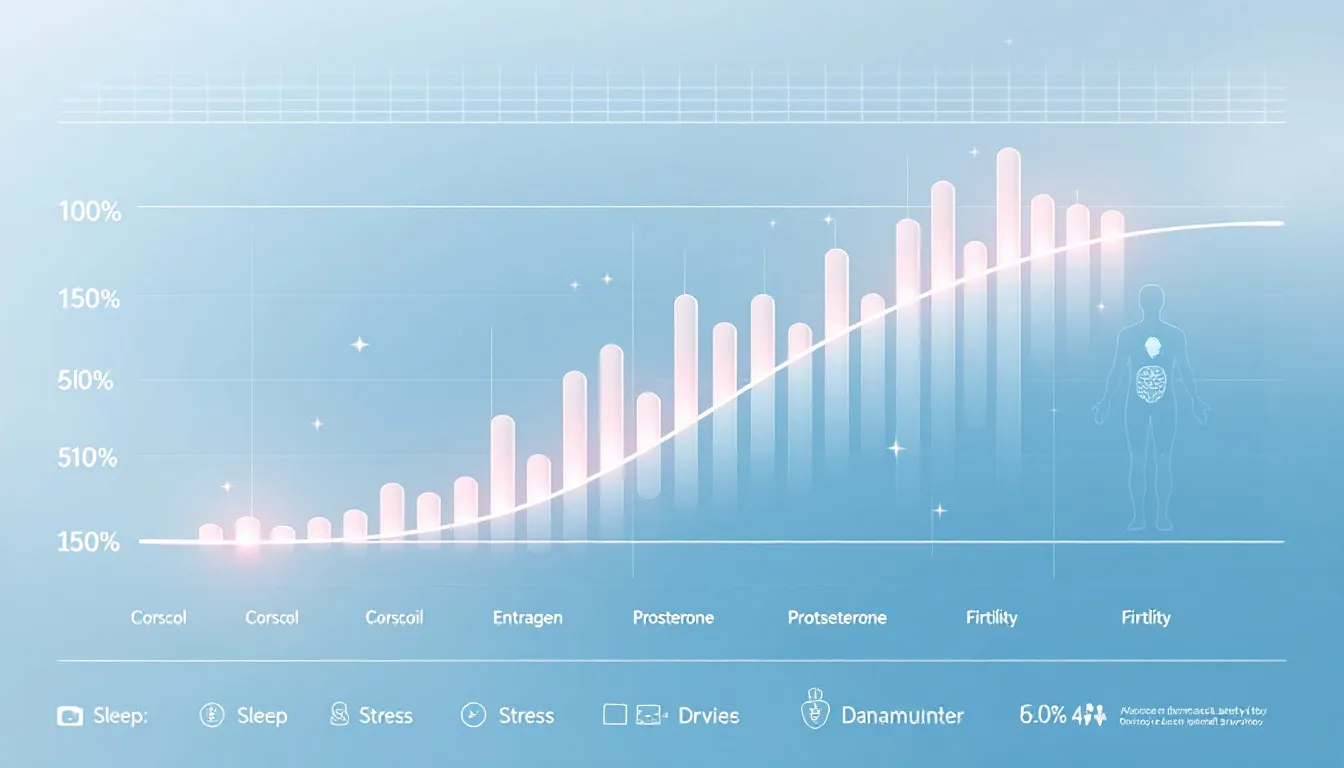A saliva test for hormones is a simple, non-invasive way to measure hormone levels in your body. It’s used to diagnose hormonal imbalances that can affect health conditions like PMS, infertility, and menopause. This article covers the benefits of saliva hormone testing and what to expect from the process.
Key Takeaways
- Saliva hormone testing is a non-invasive, cost-effective method for assessing hormonal imbalances, making it increasingly preferred in women’s health and overall clinical practice.
- Key hormones measured through saliva tests, such as estrogen, progesterone, and cortisol, provide crucial insights for managing various health conditions and guiding treatments like hormone replacement therapy and chronic disease management.
- The demand for saliva hormone testing is on the rise due to technological advancements and greater awareness of hormonal health, leading to a projected expansion of the market in the coming years.
Understanding the Importance of Hormone Testing

Hormone testing is a cornerstone of modern healthcare, offering vital insights into the body’s intricate hormonal balance. Measuring hormone levels allows health care providers to diagnose and manage conditions such as premenstrual syndrome, infertility, and menopause effectively through a hormone test, including considerations for shifting hormone levels.
Saliva hormone testing is gaining traction for its non-invasive monitoring, which simplifies tracking hormonal changes and irregularities. With the market expanding due to technological advancements and increased awareness, understanding its importance becomes increasingly critical.
Role in Women’s Health
Hormonal imbalance can profoundly impact a woman’s life, causing:
- infertility
- fatigue
- low mood
- anxiety
- irregular periods
- hormone balance
- hormone related symptoms
- hormone imbalance
Approximately 30% of women experience premenstrual syndrome (PMS), significantly disrupting daily activities. Estrogen levels and progesterone, the primary female hormones and chemical messengers, are vital for regulating the menstrual cycle and overall reproductive health.
Saliva hormone testing offers a clear picture of bioavailable salivary hormone levels, aiding health care providers in identifying imbalances and potential health issues through salivary hormone testing and a saliva hormone test.
Common Conditions Diagnosed
Saliva tests are invaluable for diagnosing various hormone-related conditions, providing essential data for addressing issues like adrenal glands fatigue and other imbalances related to the hypothalamic pituitary adrenal axis. Evaluating hormone levels against a broad range of standard reference ranges, these diagnostic tests offer critical insights into a patient’s health.
This makes saliva hormone testing a powerful tool in managing various health conditions in clinical practice.
Key Hormones Measured in Saliva Tests

Saliva hormone testing measures key hormones like estrogen, progesterone, cortisol, and other steroids, which are vital for maintaining hormonal balance. Understanding the salivary hormones and salivary progesterone levels of these biologically active hormones is crucial for assessing overall health and addressing imbalances.
Saliva tests offer a non-invasive way to analyze these hormone levels, making them valuable for health assessments.
Estrogen and Progesterone
Estrogen and progesterone are pivotal in regulating the menstrual cycle and maintaining pregnancy. Imbalances in these hormones can lead to infertility, difficulty conceiving, menstrual irregularities, and emotional disturbances such as mood swings and anxiety.
Saliva tests are particularly effective for measuring free and biologically active hormone levels, providing precise insights into hormonal status and helping manage conditions like menopausal symptoms and polycystic ovary syndrome.
Cortisol Levels
Cortisol, often referred to as the stress hormone, fluctuates throughout the day, reflecting the body’s stress levels. Measuring cortisol levels through saliva helps assess stress-related health issues and manage chronic conditions like Cushing’s disease, including the adrenocortex stress profile.
Saliva tests help monitor cortisol levels accurately, providing valuable data for treatment decisions and improving health outcomes.
Other Steroid Hormones
Saliva testing can also detect free steroid hormones like testosterone and DHEA, which are crucial for women’s health and play significant roles in bodily functions, including muscle strength and energy levels.
Saliva tests enable continuous monitoring of these hormone levels, aiding in managing chronic conditions and ensuring optimal health.
How Saliva Testing Works
Saliva testing is a straightforward yet powerful method for measuring hormone levels. It involves collecting saliva samples, which are then analyzed in a laboratory to determine hormone concentrations. This non-invasive approach is both convenient and effective, making it an attractive option for patients and healthcare providers alike.
The following subsections will delve deeper into the sample collection process, laboratory analysis, and result interpretation.
Sample Collection Process
Collecting saliva samples accurately is crucial for reliable hormone level measurements. Typically, this involves using a test kit to collect carefully timed salivary samples at multiple points throughout the day, providing a comprehensive measure hormones of hormone secretion patterns. Following recommended guidelines for timing and technique ensures reliable results.
The blood samples are returned to the laboratory. This is done using a prepaid express satchel that comes with the test kit.
Laboratory Analysis
Once in the laboratory, saliva samples are analyzed using advanced techniques like enzyme-linked immunosorbent assay (ELISA) and tandem mass spectrometry, ensuring high accuracy and reliability in hormone level measurement.
These technologies play a critical role in providing precise and trustworthy hormone assessments.
Interpreting Results
Interpreting saliva test results involves understanding reported hormone levels and their health implications. Typically, results are sent to patients via secure PDF or email, summarizing each hormone measured.
This information helps health care providers make informed treatment and intervention decisions.
Advantages of Saliva-Based Hormone Testing

Saliva-based hormone testing offers numerous advantages over traditional methods. Its non-invasive nature makes it a preferred choice for monitoring various health conditions. The cost-effectiveness and convenience of saliva tests further enhance their appeal, providing reliable assessments of biologically active hormones.
These benefits make saliva hormone testing invaluable in clinical practice.
Non-Invasive and Convenient
Collecting saliva for hormone testing is significantly less discomforting than blood drawing. The process is designed for ease and convenience, often allowing patients to collect samples at home using a test kit sent by express post. This DIY approach not only makes the process more comfortable but also ensures timely sample collection and return to the laboratory.
Cost-Effectiveness
Saliva testing is recognized for its sensitivity and affordability, making it a cost-effective option for hormone evaluations. Lower costs make saliva tests accessible to a broader range of patients, enhancing their clinical utility in various healthcare settings.
Affordability is a key factor driving the increasing adoption of saliva hormone testing.
Accuracy and Reliability
Recent innovations in saliva hormone testing technology have focused on enhancing accuracy and user-friendliness, promoting wider adoption in clinical and consumer markets. Research validates that saliva-based testing provides results as accurate as traditional blood tests.
New devices and kits have improved the precision of saliva tests, ensuring reliable detection of hormonal imbalances and supporting effective clinical interventions.
Applications in Clinical Practice

Saliva hormone testing has become an indispensable tool in clinical practice, offering accurate diagnostics and personalized treatment plans. Its applications range from hormone replacement therapy to menstrual cycle mapping and managing chronic conditions.
As healthcare providers increasingly rely on these tests, the clinical utility of saliva hormone testing expands.
Hormone Replacement Therapy (HRT)
Saliva tests personalize hormone replacement therapy (HRT) by accurately measuring hormone levels, enabling healthcare providers to adjust dosages effectively. This fine-tuning ensures optimal dosing, addressing hormone imbalances and improving overall health.
Test results often include recommendations for potential treatments based on detected hormone levels, enhancing the effectiveness of hormone therapy.
Menstrual Cycle Mapping
Saliva testing is valuable for tracking hormonal fluctuations throughout the menstrual cycle, aiding in diagnosing irregularities and understanding ovulation patterns. Daily saliva sample collection provides a more accurate mapping of hormonal fluctuations, helping identify issues such as premenstrual dysphoric disorder and menstrual irregularities.
This information is crucial for managing reproductive health and guiding treatment decisions.
Managing Chronic Conditions
Effectively managing chronic conditions often hinges on understanding hormone levels and their impact on overall health. Saliva testing provides insights into hormones like testosterone and DHEA, essential for various bodily functions. By offering valuable information on hormone levels, saliva tests help healthcare providers make informed treatment decisions, improving health outcomes and enhancing patients’ quality of life.
Market Trends and Future Outlook

The market for saliva hormone testing is growing significantly, driven by increasing demand, technological advances, and growing awareness of hormonal health. The global saliva collection and diagnostics market is projected to expand substantially in the coming years, reflecting the rising popularity of non-invasive testing methods.
Here, we explore these trends and the future outlook for saliva hormone testing.
Increasing Demand
Saliva hormone testing is becoming increasingly popular among patients seeking non-invasive hormone measurement methods. Health professionals recognize the significance and accuracy of saliva tests, contributing to their rising acceptance. The affordability and convenience of saliva tests make them accessible to a broader audience, further driving demand in the healthcare market.
Technological Advances
Recent innovations in saliva hormone testing have significantly enhanced detection capabilities and patient convenience. Advances in enzyme immunoassay techniques and the ability to measure a wider range of hormones using smaller saliva samples have improved the precision and reliability of these tests.
These technological advancements pave the way for more personalized treatment plans and timely interventions in clinical endocrinology.
Global Market Insights
The global market for saliva hormone testing is growing rapidly, driven by increasing awareness about hormonal health and the benefits of non-invasive testing methods. With the global prevalence of PMS and other hormone-related conditions, the potential market for hormone testing solutions is significant.
This growth is expected to continue as more healthcare providers adopt saliva hormone testing as a standard diagnostic tool.
Summary
Saliva hormone testing offers a non-invasive, cost-effective, and reliable method for measuring hormone levels, making it a valuable tool in modern healthcare. From personalizing hormone replacement therapy to tracking menstrual cycles and managing chronic conditions, the applications of saliva hormone testing are vast and varied. As technological advancements continue to enhance the accuracy and convenience of these tests, their adoption in clinical practice is set to grow. Embrace the future of health diagnostics with saliva hormone testing, and take control of your hormonal health today.
Frequently Asked Questions
What is saliva hormone testing used for?
Saliva hormone testing is employed to assess active hormone levels, aiding in the diagnosis and management of conditions such as PMS, infertility, menopause, and chronic stress-related disorders including Cushing’s disease. This testing provides valuable insights into hormonal health.
How does saliva hormone testing compare to blood tests?
Saliva hormone testing provides a more accurate assessment of biologically active hormones by measuring free hormones, while being non-invasive and convenient. In contrast, blood tests often measure bound hormones, which may not reflect the available hormone levels for bodily use.
What hormones can be measured through saliva testing?
Saliva testing can effectively measure hormones including estrogen, progesterone, cortisol, testosterone, and DHEA, offering valuable insights into hormonal health. This method is non-invasive and can aid in understanding various health conditions.
How are saliva samples collected for hormone testing?
Saliva samples for hormone testing are collected using a test kit, typically involving multiple collections throughout the day to capture hormone secretion patterns. This straightforward process can be performed at home.
What are the benefits of saliva hormone testing?
Saliva hormone testing offers several benefits, including its non-invasive approach, cost-effectiveness, and accuracy in measuring biologically active hormones. This convenience makes it a valuable tool in clinical practice for health diagnostics.
